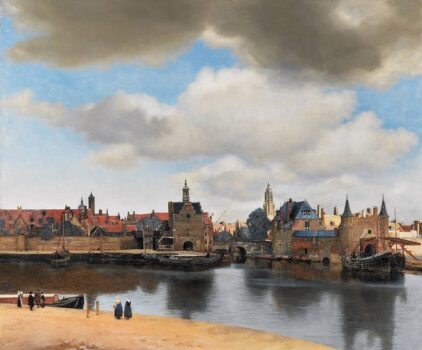An In-Depth Analysis of Johannes Vermeer’s View of Delft
Among the great treasures of European painting, Johannes Vermeer’s View of Delft (c. 1660–1661) occupies a unique place. Unlike the majority of his intimate domestic interiors, this canvas presents a rare cityscape , a panoramic view of the Dutch city of Delft, where the artist spent his entire life. At once a faithful topographical record and a deeply poetic meditation on place, time, and atmosphere, View of Delft stands as one of the most remarkable landscape paintings of the Dutch Golden Age.
This essay explores the origins and context of Vermeer’s masterpiece, the symbolism and meaning embedded within the work, what is happening in the scene, its artistic qualities, and its present location. By analyzing the painting’s details, we can better understand why this cityscape continues to fascinate scholars, artists, and visitors centuries after it was created.
Johannes Vermeer (1632–1675) was born and died in Delft, a thriving city in the Dutch Republic. Known for his meticulous technique, restrained output, and luminous handling of light, Vermeer produced fewer than 40 paintings that survive today. While most of these works depict quiet interiors with solitary women engaged in everyday tasks, View of Delft is one of only two landscapes attributed to him (the other being The Little Street).
Art historians generally date the painting to around 1660–1661, though some suggest it may have been slightly later. At this time, Delft was experiencing prosperity, civic pride, and recovery from disasters such as the 1654 gunpowder explosion, which had devastated a section of the city. Vermeer, still relatively young, turned his attention outward from the domestic world to render his beloved hometown.
Vermeer painted the scene from an elevated position on the south side of Delft, possibly from the upper floor or roof of a building near the Kolk canal. Using a careful balance of observational detail and compositional design, he portrayed the city’s skyline with striking accuracy, yet infused it with a serenity and timelessness that transcends mere topography.
What View of Delft Is All About
At first glance, View of Delft is a straightforward depiction of a Dutch city. The painting measures about 98.5 × 117.5 cm (38.8 × 46.3 in), making it one of Vermeer’s largest works. The foreground features a calm stretch of water , the Schie canal , reflecting the moored boats and parts of the sky. Beyond the water, a series of buildings, towers, and gates form the city’s profile. The sky dominates the composition, with massive cumulus clouds illuminated by shifting sunlight.
But the canvas is not merely a city portrait. Instead, it offers a contemplative vision of human community situated within nature’s rhythms. The alternation of shadow and light across the buildings conveys the passage of time. The stillness of the water suggests stability and continuity, while the figures along the shore remind us of everyday life.
In essence, View of Delft is about the relationship between humanity, city, and environment. It represents Delft not only as a geographic place but as a living organism , serene, dignified, and enduring.
View of Delft Painting Symbolism and Meaning
Although Vermeer rarely painted overt allegories, many scholars find symbolic layers in View of Delft. These meanings emerge from its treatment of light, its careful arrangement of architectural elements, and its larger cultural context.
1. The Play of Light and Time
The dramatic illumination across the canvas , sunlight breaking through clouds to strike certain buildings while others remain in shadow , may symbolize the transience of earthly existence. The fleeting nature of light suggests the passage of time, reminding viewers of life’s impermanence. Yet the solidity of the city’s architecture contrasts with this ephemerality, offering a sense of permanence and endurance.
2. Delft as a Civic Ideal
In the 17th century, Dutch city views often functioned as expressions of civic pride. By presenting Delft as orderly, tranquil, and bathed in luminous air, Vermeer may have been celebrating his hometown’s resilience after the trauma of the 1654 explosion and subsequent rebuilding. The inclusion of the Nieuwe Kerk (New Church) with its prominent tower underscores Delft’s religious and civic identity.
3. The New Church and National Memory
The Nieuwe Kerk houses the tomb of William of Orange, leader of the Dutch Revolt and founding father of the Dutch Republic. Its tower, catching the sunlight in Vermeer’s painting, stands as a symbol of freedom, Protestant faith, and national identity. Viewers at the time would have recognized this as more than just an architectural landmark , it was a sacred site of Dutch independence.
4. Boats and Waterways
The boats moored along the Schie canal suggest commerce, travel, and the lifeblood of the city’s economy. Water, too, carried deep meaning for the Dutch, whose survival depended on canals, dikes, and trade routes. In Vermeer’s painting, the placid water becomes a metaphor for balance between nature and human engineering.
5. Human Figures
Although small in scale, the figures on the quay animate the scene. Some are conversing, others walking. Their presence situates the city within lived human experience, suggesting continuity of daily life. They embody the ordinary activities that sustain community, resonating with Vermeer’s broader interest in the dignity of everyday existence.
What Is Happening in View of Delft?
The painting captures a moment of calm observation. The scene unfolds as if one were pausing to look across the canal at Delft on a day of shifting weather.
A few key elements of “action” can be discerned:
Clouds drift across the sky, casting alternating patches of light and shadow on the city.
Water lies still, reflecting portions of the boats and buildings.
Figures move quietly along the quayside , two women in the foreground seem to converse, while others walk at a measured pace.
Boats rest in harbor, their sails furled, awaiting future journeys.
The scene reflects Vermeer’s genius: by presenting an apparently ordinary, uneventful moment, he elevates it into an image of serenity and contemplation.
The View of Delft Painting Type of Art
View of Delft belongs to the genre of the cityscape, which gained popularity in the Dutch Golden Age (17th century). Dutch citizens took pride in their urban centers, often commissioning or purchasing paintings that showcased familiar skylines. These works combined civic identity with aesthetic pleasure.
However, Vermeer’s cityscape stands apart from others of its kind:
Atmospheric Emphasis – Whereas many city views emphasized precise architectural detail, Vermeer focused on the play of light, shadow, and air. His concern was less cartographic accuracy and more atmospheric truth.
Poetic Stillness – Unlike bustling market scenes or panoramic overviews filled with tiny figures, Vermeer’s Delft is serene and almost meditative.
Painterly Technique – Vermeer’s application of paint, subtle tonal transitions, and use of color (notably the deep blues and reds) give the work a luminosity rarely matched by his contemporaries.
Thus, while rooted in the Dutch cityscape tradition, View of Delft transcends the genre, approaching something closer to a philosophical meditation on place and time.
View of Delft Painting Technique and Composition
Vermeer’s technique in View of Delft demonstrates the precision and delicacy for which he is renowned. Scholars have suggested that he may have used a camera obscura , an optical device that projects images , to help with perspective and detail. Evidence includes the softness of certain passages and the way highlights shimmer, resembling optical effects.
The composition is carefully balanced:
The horizon sits relatively low, emphasizing the expansive sky.
The city is framed by darkened clouds above and water below, anchoring the luminous middle ground.
The diagonal lines of the quays and boats draw the eye toward the city gates and towers.
The alternation of sunlit and shadowed buildings creates rhythm and visual interest.
Vermeer’s palette is characteristically restrained, with muted browns, grays, and blues punctuated by brighter accents. This contributes to the painting’s calm and harmonious mood.
View of Delft Painting Reception and Influence
View of Delft has long been admired for its quiet power. The 19th-century French novelist Marcel Proust famously rhapsodized about it in In Search of Lost Time, describing it as the most beautiful painting in the world. For Proust, the luminous yellow wall in the painting held a transcendent, almost mystical quality.
Art historians continue to study the work for what it reveals about Vermeer’s methods, his city, and his artistic vision. It has influenced not only painters but also writers and filmmakers, who draw inspiration from its atmosphere of suspended time.
Where View of Delft Painting Is Located Today
Today, View of Delft resides in the Mauritshuis museum in The Hague, Netherlands. The Mauritshuis is home to one of the most celebrated collections of Dutch Golden Age paintings, including works by Rembrandt, Frans Hals, and Jan Steen. Vermeer’s masterpiece is among its highlights, often drawing visitors from around the world who wish to experience firsthand the stillness and luminosity that reproductions cannot capture.
Johannes Vermeer’s View of Delft is far more than a city portrait. Painted with extraordinary sensitivity, it presents Delft not simply as a geographic locale but as a symbol of human endurance, civic pride, and harmony with nature. Its meaning unfolds in the interplay of light and shadow, the balance between permanence and transience, and the serenity of ordinary life.
As one of only two surviving Vermeer landscapes, it provides a rare glimpse of the artist looking outward at his environment rather than inward at domestic interiors. Yet in both settings, his gift for transforming the everyday into the timeless remains evident.
Standing before View of Delft today in the Mauritshuis, viewers encounter not just 17th-century Delft but a universal meditation on place, memory, and existence. Vermeer invites us to pause, observe, and dwell in the moment , to see the world with renewed clarity, just as he once saw his beloved city bathed in the light of a passing cloud.




